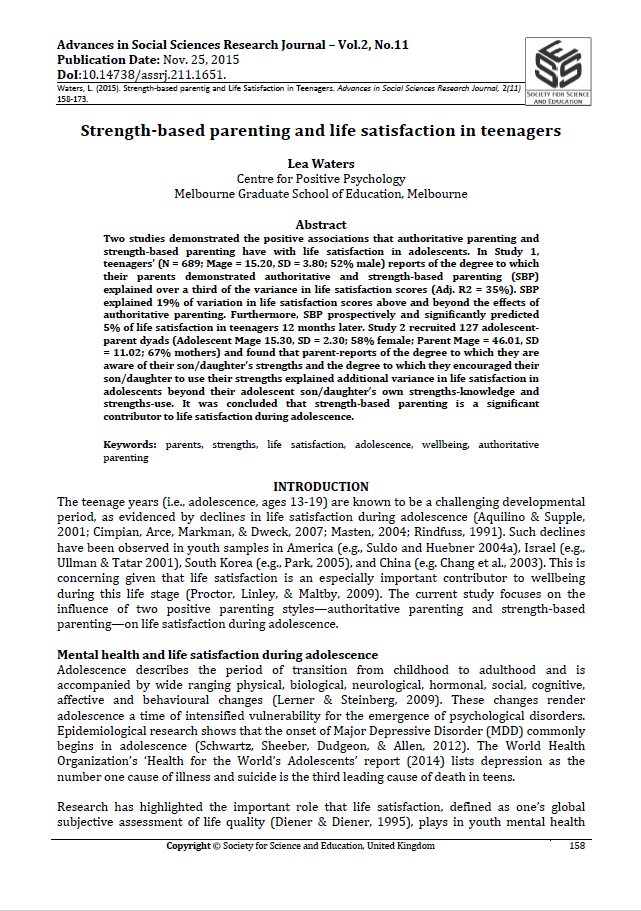
"It's a family matter": A strengths-based intervention for parents of sexual minority individuals
Introduction: Parenting a sexual minority child can pose both
challenges and opportunities for growth. This study explored
the effects of a strength-based parenting (SBP) intervention in
helping parents of sexual minority children to develop (1) psychological growth and (2) a stronger parent-child bond.
Method: Six parents participated in the intervention, interviews
were conducted before and after the intervention from parents
and children. Thematic analysis was used as the qualitative
method.
Results: SBP facilitated identity exploration, empathy, and cognitive flexibility in parents, and bolstered trust and appreciation
in the parent-child relationship.
Conclusion: Strength-based approaches hold much potential
for supporting growth outcomes in LGB-membered families.

The role of strength-based parenting, posttraumatic stress, and event exposure on posttraumatic growth in flood survivors
Determining how to promote positive psychological outcomes for survivors of floods is necessary, especially for developing countries. This study found that strength-based parenting promoted positive transformation after a flood, even in individuals who struggled with high stress. This has important
implications for practice as psychological interventions for individuals and families, as well as community-based interventions, can seek to center strength-based approaches to promote positive outcomes after these events.

Strength-based parenting and academic motivation in adolescents returning to school after COVID-19 school closure: Exploring the effect of school belonging and strength use
The present study aimed to examine whether the level of strength-based parenting a student receives during remote learning affects their levels of academic motivation once returning to school. Additionally, the study sought to explore whether school belonging mediated the association between strength-based parenting and academic motivation and whether student strength use moderated this mediating relationship.
The sample comprised of secondary school students who had recently returned back to campus, following a period of COVID-19 enforced remote learning (n = 404; age range: 11 to 18 years; M = 14.75, SD = 1.59; 50.2% female, and 3% non-/other gendered or declined to answer). Strength-based parenting had a significant predictive effect on student academic motivation with school belonging mediating the association between
strength-based parenting and academic motivation. The mediating effect of school belonging on the association between strength-based parenting and academic motivation was moderated by strength use during remote learning. The results of the study are discussed using a positive education lens with implications for improving skills and strategies to foster positive student functioning in times of remote learning and crisis.

The impact of a teacher-based positive education intervention on student wellbeing literacy
Over the past decade, research has consistently found that positive education interventions have a beneficial effect on mental health outcomes for students, such as improvements in life satisfaction and reduction of anxiety. While it is encouraging to see these changes in student mental health, the research has not yet adequately explored whether positive education interventions change a student’s understanding of wellbeing itself. Wellbeing literacy is a new construct within the field of positive education and is defined as the ability to understand the concept and language of wellbeing. This study examines whether student language and understanding of wellbeing changes following a teacher-based intervention in positive education. Students across grades five, six and seven (ages 11–13; n = 231) from three Australian schools provided brief written descriptions of their understanding of wellbeing before and after their teachers undertook an eight-month positive education intervention. Thematic analysis was used as the methodological tool to analyze student language and understanding of wellbeing. Inferential frequency-based statistical analyses were used to compare the pre-intervention and post-intervention responses. The results revealed that student understanding of wellbeing evolved in four key ways to become more: (1) detailed; (2) strength based; (3) expanded/multidimensional; and (4) relational. Post-intervention understanding of wellbeing was significantly more likely to include aspects of emotional management, strengths, coping, mindfulness and self-kindness. Implications, limitations and future directions are discussed.

Positive education pedagogy: Shifting teacher mindsets, practice, and language to make wellbeing visible in classrooms
Positive education, although only just over a decade old, has enjoyed rapid growth (Seligman & Adler, 2018; Shankland & Rosset, 2017) and can pride itself on being an innovative and expansive field (Chodkiewicz & Boyle, 2017; Waters & Loton, 2019). With the spirit of growth and innovation in mind, this chapter puts forward three key ideas for expanding the field (see Fig. 6.1).

Visible Wellbeing in schools: The powerful role of instructional leadership
It has been well established that effective school leadership extends beyond traditional leadership responsibilities (for example, policy implementation, staff management, budgeting) to also include a committed involvement in leading instructional practice. Indeed, an analysis of 280 studies by Vivienne Robinson and her team found that “leading teacher learning and development” is twice as powerful as any other leadership factor in affecting student outcomes.
Instructional leadership, especially as a shared leadership model, is vital because teacher learning has a strong impact on student learning. High quality profession-al development on instructional practice leads to improved pedagogy. Training in how to consistently evaluate the impact of teaching practice then allows teachers to ‘know thy impact’ as convincingly argued by John Hattie.While instructional leadership, over the past three decades, has focused on how teacher practice can improve academic outcomes, it can also be applied in assisting teachers to boost another equally important outcome for students – wellbeing.

How do young children understand and action their wellbeing: positive psychology and wellbeng literacy
To help build early childhood mental health, an understanding of how young children comprehend and communicate about wellbeing (i.e., wellbeing literacy) is required; yet early childhood remains an understudied age group in positive psychology research. Grounded in the two fields of early childhood and positive psychology, this inductive qualitative study examined wellbeing literacy in five- and six-year-old children. Narrative analysis of children’s drawings and explanations of wellbeing were analyzed
using a sample of children in their first year of school across two schools in Australia (n = 124 drawings, 53% girls and 47% boys). Results showed young children understand wellbeing to be an accessible and learnable state fostered through intra- and interindividual factors. Children identified the importance of their emotions, actions, relationships, and environments in shaping wellbeing. Using research methods that access the voice of young children yields important insights about wellbeing literacy that can
be used to inform the design of early childhood positive psychology interventions.

Collective wellbeing and posttraumatic growth during COVID-19: how positive psychology can help families, schools, workplaces and marginalized communities
Positive psychology approaches have been shown to play a vital role in protecting mental health in times of challenge and are, therefore, important to include when studying the psychological
outcomes of COVID-19. While existing research has focused on individual psychological health, this paper focuses on collective wellbeing and collective posttraumatic growth, with the aim of
more clearly identifying the positive experiences and potential for positive growth for key institutions in our society during the pandemic. A range of positive psychology interventions for families,
schools, workplaces, and clinical psychology are presented. The paper then considers how three broad-reaching phenomena existing in our wider society (i.e., arts and culture, eco-connection, and wellbeing literacy) can be used to boost collective wellbeing. A positive systems approach to understand civilian responses to the pandemic together with an examination of the role that positive psychology can play in supporting marginalized groups are also discussed.
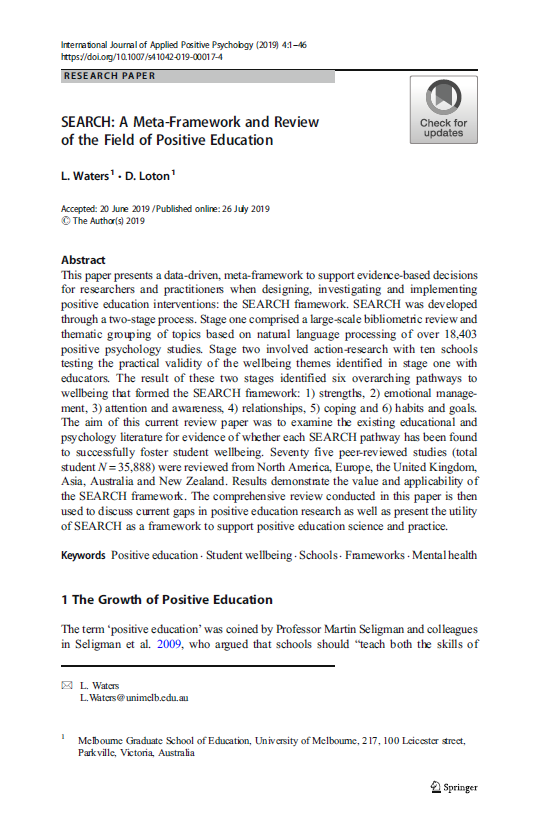
SEARCH: A meta-framework and review of the field of positive education
This paper presents a data-driven, meta-framework to support evidence-based decisions for researchers and practitioners when designing, investigating and implementing positive education interventions: the SEARCH framework. SEARCH was developed
through a two-stage process. Stage one comprised a large-scale bibliometric review and thematic grouping of topics based on natural language processing of over 18,403 positive psychology studies. Stage two involved action-research with ten schools
testing the practical validity of the wellbeing themes identified in stage one with educators. The result of these two stages identified six overarching pathways to wellbeing that formed the SEARCH framework: 1) strengths, 2) emotional management, 3) attention and awareness, 4) relationships, 5) coping and 6) habits and goals.
The aim of this current review paper was to examine the existing educational and psychology literature for evidence of whether each SEARCH pathway has been found to successfully foster student wellbeing. Seventy five peer-reviewed studies (total student N = 35,888) were reviewed from North America, Europe, the United Kingdom, Asia, Australia and New Zealand. Results demonstrate the value and applicability of the SEARCH framework. The comprehensive review conducted in this paper is then
used to discuss current gaps in positive education research as well as present the utility of SEARCH as a framework to support positive education science and practice.

Positive psychology in a pandemic: Buffering, bolstering, and building mental health
As the COVID-19 global health disaster continues to unfold across the world, calls have been made to address the associated mental illness public crisis. The current paper seeks to broaden these calls
by considering the role that positive psychology factors can play in buffering against mental illness, bolstering mental health during COVID-19 and building positive processes and capacities that may
help to strengthen future mental health. The paper explores evidence and applications from nine topics in positive psychology that support people through a pandemic: meaning, coping, selfcompassion, courage, gratitude, character strengths, positive emotions, positive interpersonal processes and high-quality connections. In times of intense crisis, such as COVID-19, it is understandable that research is heavily directed towards addressing the ways in which people are wounded and weakened. However, this need not come at the expense of also investigating the ways in which people are sustained and strengthened.

SEARCH: A meta-framework for bringing wellbeing into schools
Against a backdrop of alarming youth mental illness and declining PISA results Australian schools are spearheading the way when it comes to their pro-activeness about student wellbeing and are world leaders in the new field of ‘Positive Education’.

Searching for wellbeing in schools: A new framework to guide the science of positive education
Youth mental illness has reached alarming rates globally and, as such, international organizations such as the United Nations and the World Health Organization are calling for schools to play an active role in preventing youth distress and promoting youth wellbeing. With this in mind, the field of positive education, now a decade old, has much to offer with its emphasis on bringing the science of positive psychology to schools. However, the rapid growth of positive education has created a potentially fragmented field with a proliferation of concepts and strategies being studied and applied in isolation, with a failure to create the inter-connected, big picture of wellbeing that combines various positive education interventions in ways that synergistically build youth mental health. To address these concerns and provide a way in which to cohesively organise and build the science of positive education, a new data-driven, meta-framework for positive education called the SEARCH framework is illustrated in this paper. A discussion of how SEARCH was developed is presented together with suggestions for how researchers in education and positive psychology can use SEARCH to guide their research programs. It is hoped that the SEARCH meta-framework will steer positive education in a direction that
allows for replicability and cohesive growth.

Stress-related growth in adolescents returning to school after COVID-19 school closure
The move to remote learning during COVID-19 has impacted billions of students. While research shows that school closure, and the pandemic more generally, has led to student distress, the possibility that these disruptions can also prompt growth in is a worthwhile question to investigate. The current study examined stress-related growth (SRG) in a sample of students returning to campus after a period of COVID-19 remote learning (n = 404, age = 13–18). The degree to which well-being skills were taught at school (i.e., positive education) before the COVID-19 outbreak and student levels of SRG upon returning to campus was tested via structural equation modeling. Positive reappraisal, emotional processing, and strengths use in students were examined as mediators. The model provided a good fit [χ2 = 5.37, df = 3, p = 0.146, RMSEA = 0.044 (90% CI = 0.00–0.10), SRMR = 0.012, CFI = 99, TLI = 0.99] with 56% of the variance in SRG explained. Positive education explained 15% of the variance in cognitive reappraisal, 7% in emotional processing, and 16% in student strengths use during remote learning. The results are discussed using a positive education paradigm with implications for teaching well-being skills at school to foster growth through adversity and assist in times of crisis.

Using positive psychology interventions to strengthen family happiness: A family systems approach
A randomized wait-list control study examined the effects of two positive psychology interventions (PPIs) on 300 families across six countries. A systems approach was used to design the PPIs and to
interpret the impact of these upon family happiness. A system is an interconnected set of elements (e.g., the people, practices, rituals, and resources of a family) that are coherently organized around
a common purpose (e.g., family functioning). System approaches recognize that individuals are influenced by the environments within which they are situated and as such move beyond interventions that target individual change to look at triggering relational change. Families who undertook the PPIs were significantly happier at post-test compared to pre-intervention levels and compared to the wait-list control families. This study suggests that introducing positive practices (e.g., strength spotting) into a family may act to change the system elements and, thus, change family outcomes. System theory and Fredrickson’s broaden-and-build theory are used to explain the results.

What does positive psychology tell us about early intervention and prevention with children and adolescents? A review of positive psychological interventions with young people
This paper reviews school-based (n = 212) and clinically-based (n = 68) positive psychological interventions (PPIs) for children and adolescents. A new 3 × 3 classification of PPIs was developed
based on the processes and content of the PPI and the outcomes measured. This classification involves 9 different types of interventions depending on whether the intervention focuses on
positive, remedial, or both positive and remedial processes and content, and whether the intervention aims to evade or address challenges, deficits, or disorders or improve or elicit positive
outcomes. Positive content-balanced outcomes interventions were the most common type used in schools (38%) and clinical settings (63%). Mindfulness was the most common approach used (49%
in schools and 71% in clinical settings). Surprisingly, relatively few studies focused on well established positive psychological constructs, such as strengths, hope, and gratitude. Overall, the
results suggest strong support for the use of PPIs in school and clinical contexts.
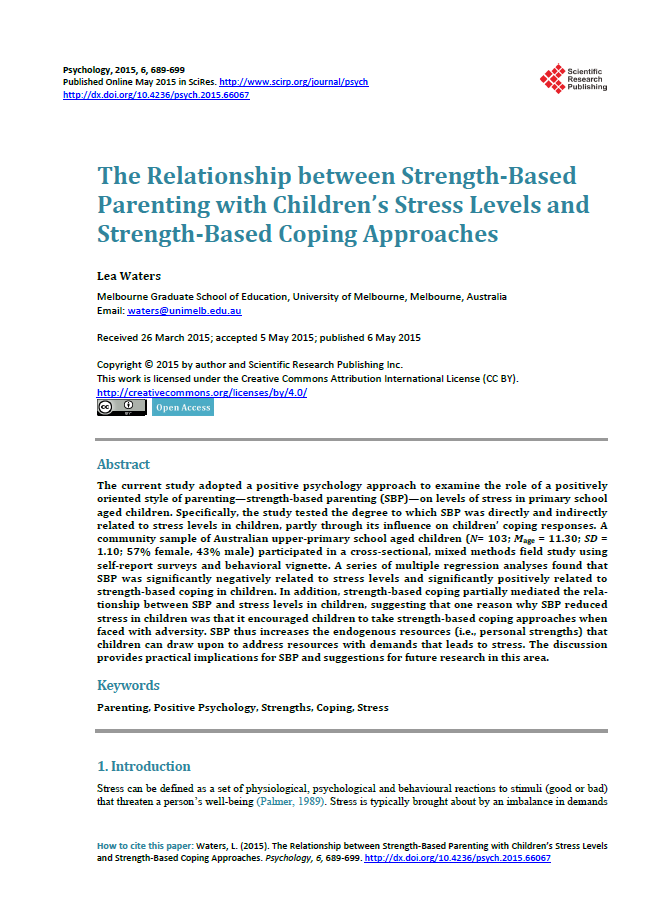
The relationship between strength-based parenting with children’s stress levels and strength-based coping approaches

Does strength‑based parenting predict academic achievement? The mediating effects of perseverance and engagement

Observing change over rime in strength-based parenting and subjective wellbeing for pre-teens and teens
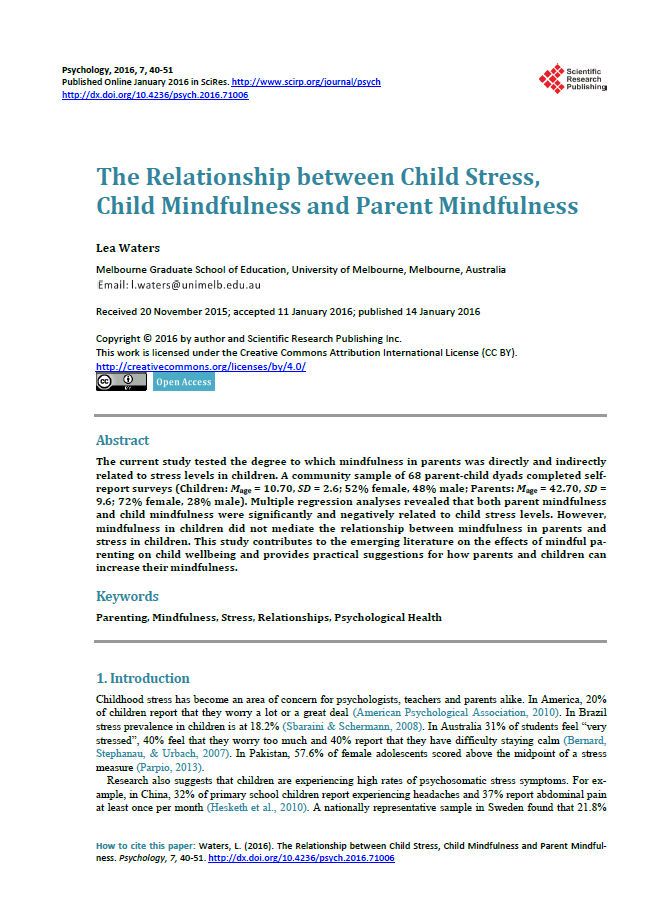
The relationship between child stress, child mindfulness and parent mindfulness
The current study tested the degree to which mindfulness in parents was directly and indirectly related to stress levels in children. A community sample of 68 parent-child dyads completed selfreport surveys (Children: Mage = 10.70, SD = 2.6; 52% female, 48% male; Parents: Mage = 42.70, SD = 9.6; 72% female, 28% male). Multiple regression analyses revealed that both parent mindfulness
and child mindfulness were significantly and negatively related to child stress levels. However, mindfulness in children did not mediate the relationship between mindfulness in parents and
stress in children. This study contributes to the emerging literature on the effects of mindful parenting on child wellbeing and provides practical suggestions for how parents and children can increase their mindfulness.
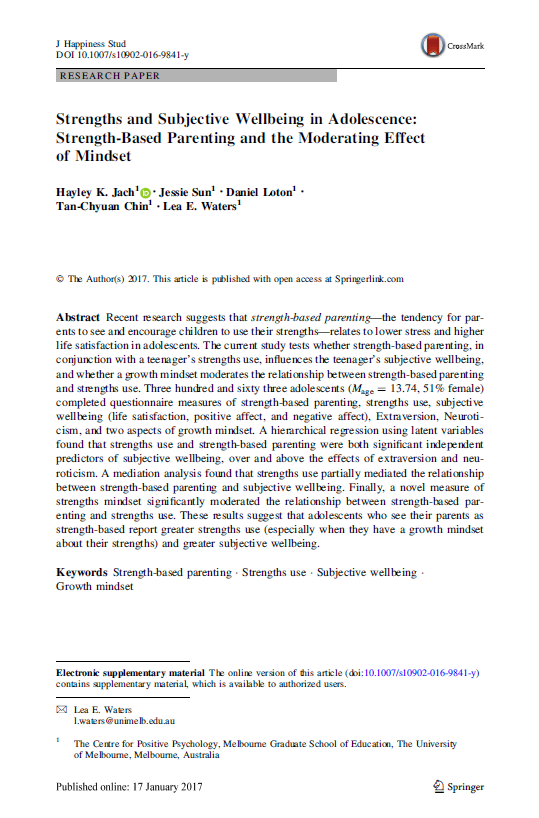
Strengths and subjective wellbeing in adolescence: Strength-based parenting and the moderating effect of mindset
Recent research suggests that strength-based parenting—the tendency for parents to see and encourage children to use their strengths—relates to lower stress and higher life satisfaction in adolescents. The current study tests whether strength-based parenting, in conjunction with a teenager’s strengths use, influences the teenager’s subjective wellbeing, and whether a growth mindset moderates the relationship between strength-based parenting and strengths use. Three hundred and sixty three adolescents (Mage = 13.74, 51% female) completed questionnaire measures of strength-based parenting, strengths use, subjective wellbeing (life satisfaction, positive affect, and negative affect), Extraversion, Neuroticism, and two aspects of growth mindset. A hierarchical regression using latent variables found that strengths use and strength-based parenting were both significant independent
predictors of subjective wellbeing, over and above the effects of extraversion and neuroticism. A mediation analysis found that strengths use partially mediated the relationship between strength-based parenting and subjective wellbeing. Finally, a novel measure of strengths mindset significantly moderated the relationship between strength-based parenting and strengths use. These results suggest that adolescents who see their parents as strength-based report greater strengths use (especially when they have a growth mindset about their strengths) and greater subjective wellbeing.
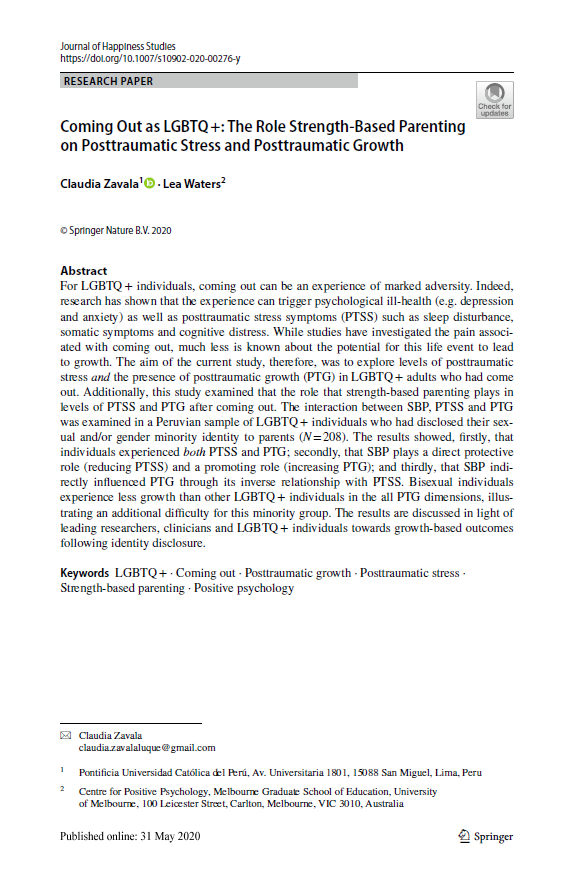
Coming out as LGBTQ +: The role strength‑based parenting on posttraumatic stress and posttraumatic growth
For LGBTQ + individuals, coming out can be an experience of marked adversity. Indeed, research has shown that the experience can trigger psychological ill-health (e.g. depression and anxiety) as well as posttraumatic stress symptoms (PTSS) such as sleep disturbance, somatic symptoms and cognitive distress. While studies have investigated the pain associated with coming out, much less is known about the potential for this life event to lead
to growth. The aim of the current study, therefore, was to explore levels of posttraumatic stress and the presence of posttraumatic growth (PTG) in LGBTQ + adults who had come out. Additionally, this study examined that the role that strength-based parenting plays in
levels of PTSS and PTG after coming out. The interaction between SBP, PTSS and PTG was examined in a Peruvian sample of LGBTQ + individuals who had disclosed their sexual and/or gender minority identity to parents (N = 208). The results showed, firstly, that
individuals experienced both PTSS and PTG; secondly, that SBP plays a direct protective role (reducing PTSS) and a promoting role (increasing PTG); and thirdly, that SBP indirectly influenced PTG through its inverse relationship with PTSS. Bisexual individuals
experience less growth than other LGBTQ + individuals in the all PTG dimensions, illustrating an additional difficulty for this minority group. The results are discussed in light of leading researchers, clinicians and LGBTQ + individuals towards growth-based outcomes following identity disclosure.

Tracing the growth, gaps, and characteristics in positive education science: A long-term, large-scale review of the field
This large-scale quantitative review used publication data to track the presence of positive education terms over a 100+ year period across 35 psychology journals and education journals utilizing two analytical methods. First, computer-generated linguistic word count analysis identified that positive education terms have shown small but steady growth in psychology and education research for more than a century. From 1904 to 2016, positive education terms have risen consistently, with increases in 1952, 1982, 2010, and 2014 to over 4, 5, 6, and 7 percent, respectively. Four new terms were present in the top 20 most prevalent terms following the official launch of positive education in 2009: well-being, satisfaction, motivat*, and engag* (note: terms ending with an asterisk are word stems). Three terms also increased in rank order prevalence from 2009 onwards: emotion*; health; and goal*. The second analytical method involved in-depth human coding of a subset of positive education abstracts (n = 2,805) by a team of five researchers1 to identify trends pertaining to how positive education research has been conducted in terms of paradigms, designs, methods, tools, samples, and settings from 1950 to 2016. College students and students in secondary school make up the most common samples, with little research in the early childhood years. Quantitative, cross-sectional studies using self-report surveys have been the most common design and method used over the past six decades, suggesting room for growth in qualitative methods and the need for greater longitudinal and intervention designs. The human coding was also used to classify positive education variables into broader categories of research. Nine categories were identified: positive functioning; well-being; ill-being; strengths; agency; connection and belonging; identity and personality; school climate and outcomes; and demographics. By tracking positive education science over time, the current paper allows researchers to take stock of the field, identify gaps, outline areas of growth, and pursue fruitful topics for future research.

Using Metaphors to Shine a Light on Wellbeing Education
Despite the increased attention on wellbeing over the decades, scholars and the general public continue to question how wellbeing is best understood and defined. One valuable tool to assist people in conceptualising wellbeing is the use of metaphor. Often adopted to describe complex phenomena in a simple and relatable way, metaphors have been used as a powerful learning tool in fields such as medicine, psychology, and business to aid understanding of a range of topics, including the human body, therapy, family dynamics and workplace conflict. The power of metaphors to convey vivid imagery, encourage intuitive interpretation, and illuminate deep understanding stands them in good stead to be used in wellbeing education. This chapter makes a case for the broad, intentional, and strategic use of metaphors in wellbeing education to promote wellbeing literacy, increase student voice, and help design whole-school wellbeing approaches that ultimately boost teachers’ and students’ wellbeing .

Strength‐based parenting and stress‐related growth in adolescents: Exploring the role of positive reappraisal, school belonging, and emotional processing during the pandemic
Introduction: Coronavirus disease 2019 (COVID‐19) has changed the way families live, interact, and connect with others, resulting in higher levels of stress for many teenagers who struggle with the ongoing uncertainty and disrupted school and family life. The current study examined the psychosocial factors that influence the capacity of adolescents to grow through the stress of the COVID‐19 pandemic.
Methods: The sample included 404 secondary school students ranging in age from 11 to 18 (M= 14.75, SD = 1.59; 50.2% female, 46.8% male, and 3% non‐/other gendered or declined to answer) from an independent high school in Australia. Data were collected from a battery of questionnaires that assessed strength‐based parenting
(SBP) and the effect of three psychosocial factors (positive reappraisal, emotional processing, and school belonging) on stress‐related growth.
Results: Structural equation modeling showed that (SBP) was significantly associated with stress‐related growth (SRG). Positive reappraisal and emotional processing were also positively and significantly associated with SRG and mediated the effect of SBP on
SRG. Moreover, school belonging was positively linked to positive coping, emotional processing, and SRG, as well as mediating the association of SBP with positive reappraisal, emotional processing, and SRG in adolescents during the pandemic.
Conclusions: The results show that teenagers can experience SRG during the COVID‐19 pandemic, and adolescents adapting by engaging in constructive coping responses such as positive reappraisal and emotional processing is positively related to SRG.
















